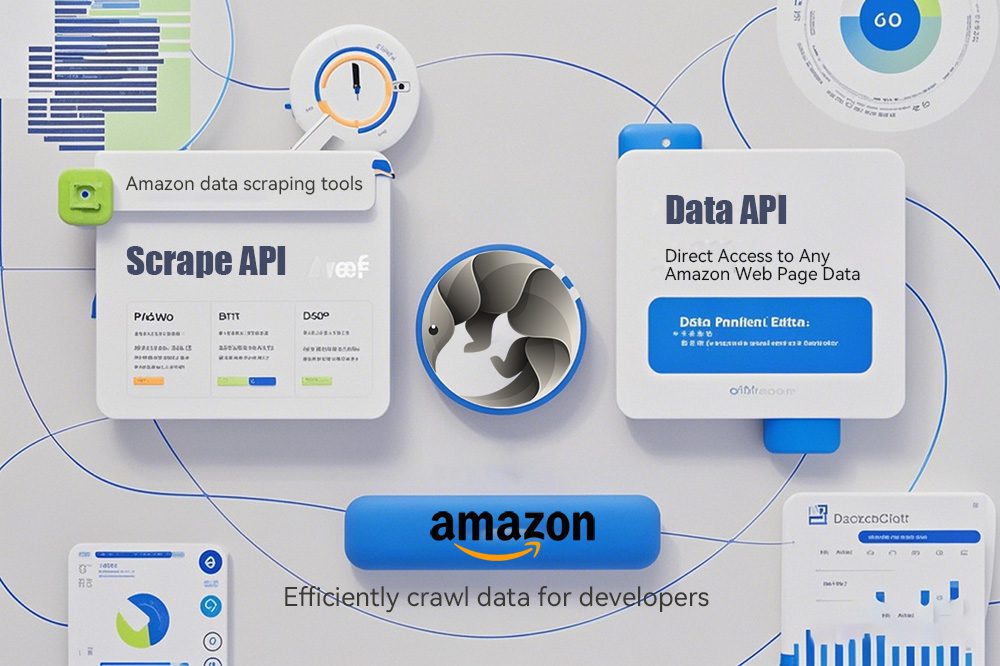I. Introduction
A. The Importance of Amazon Data Scraping
In today’s competitive e-commerce landscape, Amazon data scraping is crucial for sellers, brands, and market analysts. Gathering data such as product details, prices, reviews, and inventory from Amazon allows businesses to make data-driven decisions that can enhance product strategies and improve overall operational efficiency. Using efficient data scraping tools ensures businesses stay ahead of market trends, optimize sales performance, and increase profitability.
B. The Role of APIs in Data Scraping
APIs (Application Programming Interfaces) play an essential role in automating data scraping. They allow users to programmatically access large amounts of data from platforms like Amazon. APIs help businesses collect customized data without manual effort. Two commonly used types of APIs for data scraping are Scrape API and Data API, each providing different features suited to varying data needs and business requirements.
C. Overview of Scrape API and Data API
- Scrape API: Simulates user behavior to scrape raw data from Amazon’s web pages. Ideal for users who need access to unstructured or vast amounts of data.
- Data API: Provides structured, pre-processed data, saving users from the need to clean and parse raw data. It is ideal for users looking for quick integration and ready-to-use data.
II. Challenges in Amazon Data Scraping
A. Large Data Volume and Frequent Updates
Amazon’s product data, pricing, inventory, and customer reviews change frequently. Sellers need continuous, real-time data to stay competitive and responsive to market dynamics.
B. Anti-Scraping Mechanisms
Amazon employs robust anti-scraping measures to limit unauthorized large-scale data requests and protect the platform. Overcoming these barriers while maintaining compliance is one of the primary challenges in data scraping.
C. Complex Data Structures
Amazon’s data comes in diverse formats, including structured product information and unstructured user reviews or media. Extracting meaningful insights from these complex data structures requires advanced data handling capabilities.
D. High Real-Time Data Demand
Real-time data is critical for e-commerce decisions, such as dynamic pricing or inventory management. Any delay in data collection could lead to missed opportunities or inaccurate decision-making.
III. Scrape API: In-Depth Analysis
A. What Is Scrape API?
Scrape API is a tool designed to scrape raw data from web pages by simulating user interactions. This type of API is especially useful for collecting non-standardized or raw data, such as product listings, reviews, and price histories, directly from Amazon.
B. How Scrape API Works
Scrape API sends HTTP requests to access web pages and extract HTML content. This raw HTML is then parsed to extract specific data. To handle Amazon’s anti-scraping measures, Scrape API typically uses rotating proxies, IP pools, and randomized user-agent headers to ensure continuous and stable data scraping.
C. Key Features of Pangolin’s Scrape API
1. Full-Site Data Collection
Pangolin’s Scrape API enables users to scrape all available public data on Amazon, including product details, reviews, and price changes. This ensures comprehensive data collection for market analysis.
2. Anti-Ban Technology
Pangolin Scrape API utilizes advanced anti-ban mechanisms such as rotating IP pools, proxy servers, and dynamic user agents to bypass Amazon’s restrictions and prevent the IP from being blocked.
3. High Concurrency Support
Pangolin’s Scrape API supports high concurrency, allowing users to send multiple requests simultaneously and scrape large amounts of data in a short time, making it suitable for enterprise-level data scraping tasks.
IV. Data API: Comprehensive Overview
A. Definition and Functionality of Data API
Data API offers structured, pre-processed data that is ready to use. Instead of scraping raw web pages, it provides data that is already cleaned and organized. This API is ideal for businesses that want to integrate real-time data directly into their applications with minimal effort.
B. Advantages of Data API
Compared to Scrape API, Data API includes the cost of parsing and cleaning data, providing well-structured information. It reduces the complexity of handling raw data and allows faster integration into systems, making it ideal for real-time applications that require quick decision-making.
C. Key Features of Pangolin’s Data API
1. Real-Time Amazon Data Parsing
Pangolin’s Data API offers real-time Amazon data, ensuring that users receive the latest information regarding products, pricing, and inventory, making it suitable for time-sensitive business decisions.
2. Structured Data Output
Data API delivers pre-cleaned, structured data, removing the need for manual parsing. This makes it easier to incorporate the data directly into your business processes, saving both time and resources.
3. Easy Integration Interface
Pangolin’s Data API is designed with an intuitive, easy-to-use interface, enabling developers to quickly integrate it into existing systems without heavy development overhead.
V. Scrape API vs Data API: Detailed Comparison
Below is a side-by-side comparison of Scrape API and Data API, highlighting their key differences:
| Criteria | Scrape API | Data API |
|---|---|---|
| Data Acquisition | Scrapes raw data from Amazon’s web pages | Provides structured, pre-processed data |
| Data Processing | Requires users to clean and parse raw data | Data is already cleaned and structured |
| Response Speed | Slower due to HTML parsing and extraction | Fast, as data is delivered pre-processed |
| Ease of Use | Requires higher technical skills for data handling | Easy to integrate, with minimal data handling needed |
| Cost Efficiency | Suitable for large-scale data tasks; lower upfront costs, but higher data processing effort | Includes parsing and cleaning costs; higher upfront cost, but saves time on processing |
| Best Use Cases | Ideal for unstructured data and when customization is needed | Best for real-time, structured data requirements |
VI. How to Choose the Right API for Your Needs
A. Assess Your Data Requirements
1. Data Types (e.g., Product Info, Reviews, Sales Rank)
Evaluate what kind of data you need. If your business requires detailed product information, user reviews, or sales rank data, you may need Scrape API for its flexibility or Data API for its structured output.
2. Data Volume and Update Frequency
If you require large amounts of frequently updated data, Scrape API’s ability to handle high concurrency may be more appropriate. On the other hand, if you need instant data with minimal delay, Data API is the better choice.
3. Real-Time Requirements
If your business operations depend on real-time data, Data API’s faster response time will ensure you receive up-to-date information, making it the ideal solution for time-sensitive use cases.
B. Consider Your Technical Resources
Scrape API requires more technical expertise to manage data cleaning, parsing, and handling anti-bot measures. Data API, however, offers an easy-to-use interface, making it suitable for businesses with limited technical resources.
C. Budget Considerations
While Scrape API offers more flexibility and lower upfront costs, the ongoing effort to clean and process the data may increase overall expenses. Data API, which includes parsing and cleaning, has a higher upfront cost but may be more cost-effective in the long run, especially for those seeking ready-to-use data.
D. Long-Term Scalability
As your business grows, you may need to scale up your data collection efforts. Scrape API offers high flexibility and can handle more complex and large-scale data scraping tasks. Data API, on the other hand, is more suitable for businesses looking for stable, structured data with long-term integration.
VII. Pangolin Data Service: A Comprehensive Solution
A. The Combined Advantages of Scrape API and Data API
Pangolin offers both Scrape API and Data API, providing users with the flexibility to choose the most appropriate solution based on their data needs. Businesses can use Scrape API for large-scale data extraction while leveraging Data API for quick access to structured, real-time data.
B. Pangolin Scraper: A Visual Data Scraping Tool
1. User-Friendly Interface
The Pangolin Scraper offers an intuitive, visual interface that allows even non-technical users to collect Amazon data quickly and efficiently.
2. Customizable Data Fields
Users can customize the data fields they wish to scrape, ensuring that they only gather the data relevant to their business, reducing storage and processing costs.
3. Export to Excel Format
Pangolin Scraper allows users to export data in Excel format, making it easier to share and analyze the collected information with teams.
C. Maximizing Efficiency with Pangolin Tools
By combining Scrape API, Data API, and Pangolin’s visual scraper, businesses can cover all their data needs—from large-scale raw data extraction to structured data analysis. This comprehensive approach maximizes data collection and analysis efficiency.
VIII. Case Studies
A. Large-Scale Market Analysis Using Scrape API
A large e-commerce brand used Scrape API to gather comprehensive market data on competitors’ product listings, prices, and customer reviews. This helped them adjust their pricing strategies and optimize their product listings to gain a significant market advantage.
B. Real-Time Pricing Strategy with Data API
An electronics seller used Pangolin’s Data API to monitor real-time pricing data on Amazon, enabling them to implement dynamic pricing strategies that improved sales conversion and profitability.
C. Successful Use of Pangolin’s Comprehensive Tool Suite
A cross-border e-commerce platform successfully combined Pangolin’s Scrape API, Data API, and visual scraper to automate market monitoring, inventory management, and pricing adjustments, significantly improving their operational efficiency and competitiveness.
IX. Implementation Guide: Getting Started with Amazon Data Scraping APIs
A. Registration and API Key Acquisition
You can easily register on Pangolin Data Service’s platform to obtain API keys and start using Scrape API and Data API for data collection.
B. Basic API Call Examples
Pangolin provides detailed API call examples and documentation to help users quickly integrate and start using the data scraping tools.
C. Common Issues and Solutions
Pangolin’s support team addresses common issues, such as API rate limits, data parsing challenges, and IP blocking, ensuring smooth usage of their APIs.
D. Best Practices for Efficient Data Scraping
Pangolin recommends setting appropriate request rates, optimizing proxy pools, and regularly monitoring API performance to maximize the efficiency of your data scraping tasks.
X. Future Outlook: The Evolution of APIs in Amazon Data Scraping
A. Integration with AI and Machine Learning
The future of data scraping will see the integration of AI and machine learning, enabling sellers to automatically analyze data and generate actionable insights, thus improving the accuracy and speed of decision-making.
B. More Granular Data Classification and Analysis
APIs will offer more granular data classification and analytics capabilities, helping businesses better understand market demand, customer preferences, and competition.
C. Possibilities of Cross-Platform Data Integration
As API technology evolves, cross-platform data integration will become easier, allowing sellers to gather and analyze data from multiple e-commerce platforms, giving them a holistic view of the market.
XI. Conclusion
A. Recap of Scrape API and Data API
Scrape API is ideal for large-scale raw data extraction, while Data API provides pre-processed, structured data for real-time use. Both have distinct advantages depending on your business needs.
B. The Importance of Choosing the Right Tool
Selecting the right API is crucial for efficient data-driven decision-making. Depending on your technical capabilities, data needs, and budget, either Scrape API or Data API—or a combination of both—can help your business thrive.
C. How Pangolin Data Service Meets Varied Needs
Pangolin offers a comprehensive suite of tools, including Scrape API, Data API, and the Pangolin Scraper, ensuring that businesses have access to flexible, efficient solutions for all their Amazon data collection and analysis needs.
XII. Action Steps
A. Evaluate Your Specific Data Needs
Assess your data needs, including data types, volume, update frequency, and real-time requirements.
B. Contact Pangolin Data Service for More Information
Reach out to Pangolin for detailed information about their API features, pricing, and technical support.
C. Start Your Data-Driven Decision-Making Journey
Leverage Pangolin’s APIs to drive your data collection strategy, helping you make smarter, data-driven decisions for your business’s growth.






